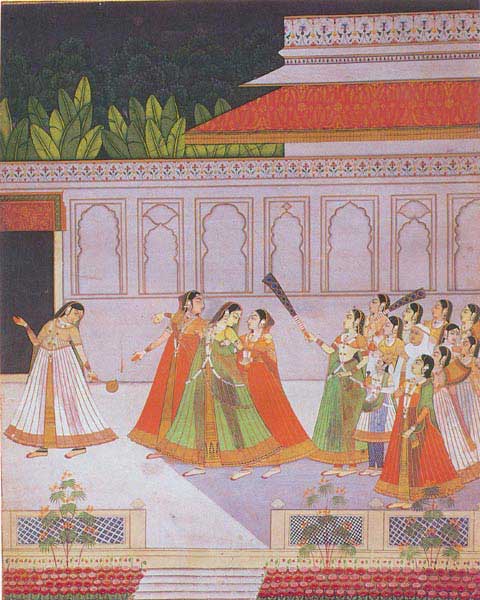Rajput painting, also known as Rajasthani Painting, is a style of Indian painting, evolved and flourished during the 18th century in the royal courts of Rajputana, India, flowing from the style of Mughal painting, itself derived from the Persian miniature. Each Rajput kingdom evolved a distinct style, but with certain common features. Rajput paintings depict a number of themes, events of epics like the Ramayana and the Mahabharata, Krishna’s life, beautiful landscapes, and humans. Miniatures in manuscripts or single sheets to be kept in albums were the preferred medium of Rajput painting, but many paintings were done on the walls of palaces, inner chambers of the forts, havelis, particularly, the havelis of Shekhawati, the forts and palaces built by Shekhawat Rajputs.
 The colours were extracted from certain minerals, plant sources, conch shells, and were even derived by processing precious stones. Gold and silver were used. The preparation of desired colours was a lengthy process, sometimes taking weeks. Brushes used were very fine.
The colours were extracted from certain minerals, plant sources, conch shells, and were even derived by processing precious stones. Gold and silver were used. The preparation of desired colours was a lengthy process, sometimes taking weeks. Brushes used were very fine.In the last decades of the 16th Century Rajput art schools began to develop distinctive styles combining indigenous as well as foreign influences (Persian, Mughal, Chinese, European) into unique styles. Various identifiable styles developed in different Rajput art schools particularly at Amber (near present-day Jaipur), Bikaner, Marwar (Jodhpur), Mewar (Udaipur), Kishangarh, Pratapgarh, Kota, Bundi, Nathdwara, Kangra, Kulu, and Guler. Jitendra Sahoo is a famous artist of Rajput painting.




